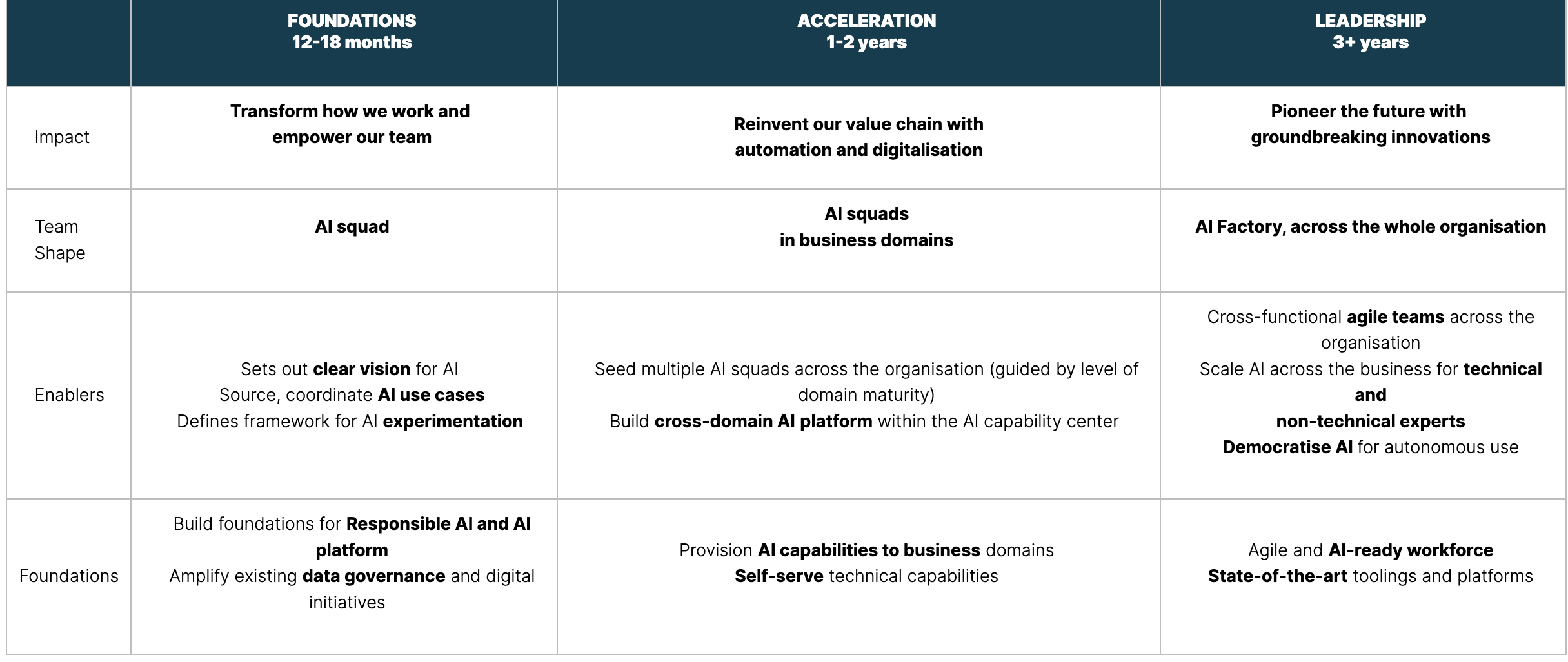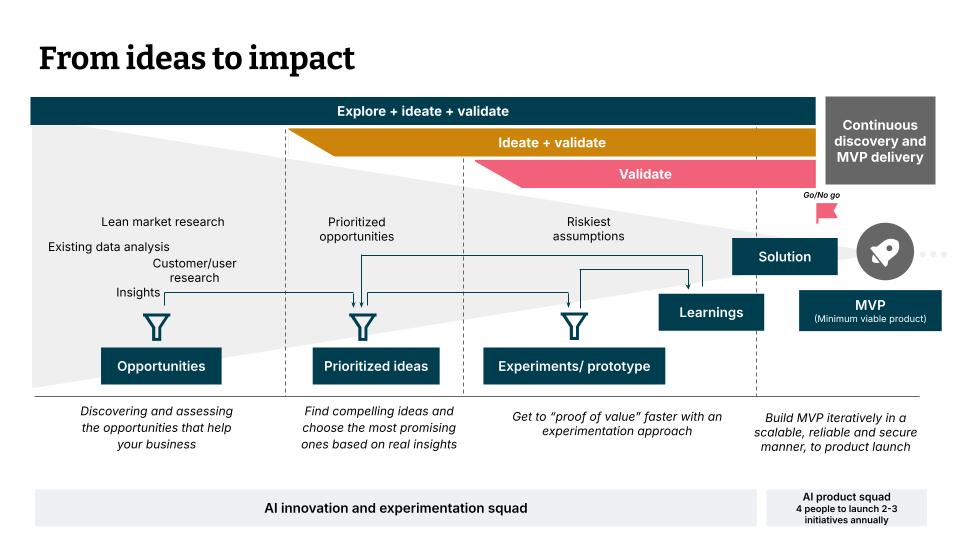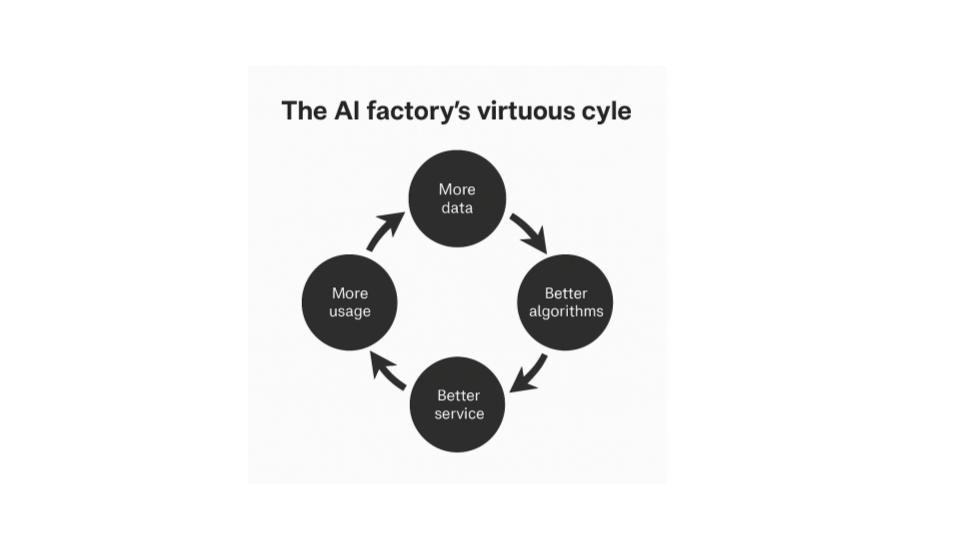Artificial intelligence is having its ‘internet moment’. Since the launch of ChatGPT, the sense of urgency has increased. Yet beneath the hype lies a stubborn reality: while 70% of companies report piloting AI, 88% of POCs didn’t make it into widescale deployment . Too often, the pattern repeats: numerous promising pilots launched with no clear path to scale, eroding confidence and growing scepticism.
Why do so many AI efforts stall? It’s rarely the technology alone. Misaligned priorities, scattered experimentation, legacy data, talent shortages and a fast-changing regulatory landscape often slow progress. At the same time, societal concerns around bias, privacy and transparency add further complexity. Leaders face a clear paradox: the cost of inaction is rising, but moving without the right foundations can be costly.
One lesson is becoming clear: unlocking value from AI depends less on algorithms, and more on how an enterprise organizes to use them responsibly and at scale. Who builds the models, how teams collaborate, and how risks are managed ultimately determines whether AI remains stuck in pilot mode or becomes a repeatable engine for value.
The AI-enabled enterprise as a journey
For most organizations whose core business isn’t technology, becoming AI-enabled is a gradual evolution not an overnight shift. But before launching teams or allocating budget, there must be a clear vision for how AI will support the business.
Without that clarity, even the most capable AI or data science teams risk being underused or disbanded — a pattern we see all too often.
With strategic intent in place, organizations can build capability over time. AI maturity is best viewed as a journey: from focused experimentation, to distributed adoption and ultimately to an industrialized ‘AI factory’ where capabilities are embedded and continuously improved across the enterprise (see graphic below).
Moving towards an AI-enabled organisation
The organization will begin with a single squad focused on building momentum and jump-starting AI journey. As these first initiatives gain traction, the squads will grow and gradually embed themselves into key business areas. Ultimately, this approach will empower teams to become autonomous and eventually lead to the AI Factory across the enterprise.


Let’s unpack these stages.
Stage 1: Dedicated AI squad -— getting started right
Innovation endeavours need a safe space to experiment. A dedicated AI team — typically an agile team of five or six software engineers, data scientists, ML engineers and a product manager — enables the business to build capabilities and deliver early use cases. The team works closely with business stakeholders and domain experts to ensure relevance and traction. Where Gen AI is the focus, strong software engineering and solution architecture skills are especially important to prototype, integrate and scale effectively.
Early success depends on disciplined prioritization. Too many early AI teams chase novel ideas with little strategic value. A transparent framework, balancing feasibility, business value and risk, helps identify use cases worth funding.
Equally important is providing a ‘sandbox’ for continuous innovation: an environment where experiments can run fast without threatening live systems (per graphic below). In AI, uncertainty is a feature, not a bug - the metric that matters is learning velocity. Early squads should be measured on experiments run, not just solutions deployed.
Done well, this first squad does more than deliver a handful of wins - it seeds the AI platform foundations, develops early talent, and creates credible success stories to inspire buy-in.


Stage 2: Distributed AI squads — scaling what works
Once the initial squad demonstrates value, the next step is to embed AI more deeply into the business. This means forming domain-aligned squads, located in functions like marketing, sales, operations, risk or product; and that can build and integrate AI solutions where value is created and decisions are made.
But scaling isn’t just about hiring more people. It requires thoughtful design. Which domains are ready? Is the tech stack modular and reusable enough to avoid starting from scratch? Are local leaders prepared to sponsor AI adoption and drive change? Not every function will move at the same pace and that’s okay. Forcing uniformity too early often backfires.
To make this stage more executable, prioritise domains where:
There is a clear problem owner (ideally someone with P&L accountability), and
There’s already demand for analytical solutions that AI can accelerate.
Start small and focused, don’t aim to “distribute everywhere” immediately. Begin where there’s real traction, then build momentum through visible wins.
Change management becomes critical at this stage. Employees need support to adapt workflows, trust AI-generated insights and experiment within safe boundaries.
Role of the AI CoE in accelerating and democratizing AI
As AI adoption expands across the enterprise, a well-designed center of excellence (CoE) can support scaling responsibly and efficiently. The CoE provides the structure, guidance and shared capabilities needed to support distributed teams while maintaining consistency.
In the context of Gen AI, initial efforts often focus on foundational needs — such as software infrastructure, tooling and safe deployment practices. More advanced capabilities, like fine-tuning Gen AI models or building bespoke architectures, typically emerge once organizational maturity and use case demand reach a sufficient threshold.
The CoE’s purpose is to align governance, technology, skills and business priorities, ensuring AI is deployed safely, sustainably and with measurable value. Done well, it doesn’t slow teams down; it accelerates them by providing guardrails, reusable assets and training to democratize AI across technical and non-technical teams alike.
Stage 3: AI Factory — industrializing for repeatable value
At full maturity, an AI-enabled organization operates like a modern industrial factory — but for decision-making and learning. Rather than producing physical goods, an AI factory systematically transforms raw data into predictions, insights and automated actions that scale across every process.
Real-world examples of organizations that operate like AI factories:
TikTok’s AI-driven feed learns user preferences in real time, tailoring endless content streams that maximise engagement and time spent.
Amazon adjusts millions of prices and supply chain routes in real time using AI.
John Deere deploys smart farming equipment that self-optimises performance based on live data.
As Competing in the Age of AI highlights, the AI Factory breaks the link between growth and headcount by embedding intelligence into workflows and products. It acts as a digital operating system, powered by data, algorithms, experimentation, and infrastructure, continuously learning from every interaction to drive faster, more consistent decisions at scale. Each transaction, customer interaction or sensor signal feeds back into the system, improving predictions over time and creating a virtuous cycle.


Figure 1: adapted from Competing in the Age of AI
Today, this idea is evolving further with agentic AI — systems that don’t just predict but act independently in context. While still nascent, these capabilities signal a shift from AI as a passive tool to an active collaborator in business processes, augmenting humans.
Navigating the journey: practical recommendations
The path to becoming an AI-enabled enterprise is rarely linear but a few principles hold true:
✔ Start with business value. Focus on problems leaders are incentivised to solve. Tie AI outcomes to executive objectives to drive commitment.
✔ Fund experimentation with intent. AI is probabilistic, not every pilot will succeed, but each one offers valuable organizational learning. Allocate budget and secure senior sponsorship to ensure teams can experiment with purpose and continuity.
✔ Drive from both the top and bottom. Leadership must set direction and create accountability, while teams on the ground need the skills, tools and space to build.
✔ Design for scale from the start. Avoid one-off solutions by building modular platforms, reusable assets and processes that can evolve over time.
✔ Rewire how work gets done. The real impact of AI isn’t just smarter models, it’s in reimagining workflows, roles and decision-making across the organisation.
The destination is dynamic
In AI, there is no end point. New architectures, agentic AI capabilities, and changing regulations keep moving the goalposts. What matters is not reaching an endpoint, but building a muscle to adapt, learn and industrialise insights at pace.
In a market where capital punishes inertia, organizing for AI is no longer optional. It is the operating model upgrade that separates the incumbents who scale value from those forever stuck in pilot mode.
Disclaimer: The statements and opinions expressed in this article are those of the author(s) and do not necessarily reflect the positions of Thoughtworks.


















